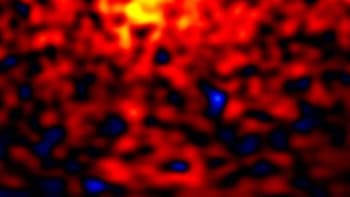
The first aurora ever seen in an object beyond our solar system has been discovered by an international team of researchers. The team was studying a brown dwarf 20 light-years away, using both radio and optical telescopes, when the researchers picked up signals that suggest that the object hosts the most powerful aurora seen to date. Indeed, the aurora is hundreds of thousands of times more powerful than any detected in the solar system. This discovery also reveals a major difference between the magnetic activity of more-massive stars and that of brown dwarfs and planets.
Auroras are natural light displays in the sky that form when charged particles from cosmic rays or the solar wind enter a planet’s magnetosphere – the region where charged particles are affected by a planet’s magnetic field. Once in the magnetosphere, the particles – mainly electrons and protons – are accelerated along the magnetic-field lines to the planet’s poles. There they collide with gas atoms in the atmosphere and produce the bright light emissions that we see as auroras. They occur on all of the magnetized planets in the solar system, and the gas giant Jupiter has the most powerful auroras.
In the middle
Brown dwarfs are “sub-stellar” objects with masses that lie between the heaviest gas giants and the lightest stars, with an upper limit of about 75 to 80 Jupiter masses. They are too small to sustain the hydrogen-fusion reactions that power main-sequence stars like the Sun. However, they are too big to be thought of as planets. Indeed, they contain characteristics of both, and are often referred to as “failed stars”.
More than a decade ago, astronomers began picking up radio waves emitted by brown dwarfs. It was initially thought that the waves were produced in much the same way as signals from other stars – in an extremely hot upper atmosphere or “corona” that is heated via magnetic activity occurring in the lower atmosphere. But brown dwarfs do not generate large flares and charged-particle emissions in the way that main-sequence stars like the Sun do, so the radio emissions remained something of a mystery.
In 2006, while a postgraduate, Gregg Hallinan – who is now assistant professor of astronomy at California Institute of Technology – discovered that brown dwarfs actually pulse at radio frequencies. “We see a similar pulsing phenomenon from planets in our solar system,” says Hallinan, “and that radio emission is actually down to auroras.” Hallinan wondered if the radio emissions coming from brown dwarfs might be caused by auroras too.
Hallinan – together with Stuart Littlefair from the University of Sheffield in the UK and colleagues worldwide – made extensive observations of a sub-stellar object, called LSR J1835+3259, that is most likely a brown dwarf. To study the object at radio wavelengths, the team used the Very Large Array (VLA), while optical observations were made using the Hale Telescope on Palomar Mountain and the Keck telescopes in Hawaii.
Peculiar pulses
The researchers’ radio observations showed a bright pulse of radio waves that appeared as the brown dwarf rotated every 2.84 hours – the team was able to observe nearly three full rotations over the course of a single night. The Hale Telescope revealed that the brown dwarf varied optically on the same period as the radio pulses. Focusing on one of the spectral lines associated with the H-alpha emission line of hydrogen, the researchers saw that the object’s brightness varied periodically. Lastly, the Keck telescopes were used to make a precise measurement of the brown dwarf’s brightness over time – a difficult task considering the objects’ dimness compared with the Sun.
With all of the observations combined, the team was able to establish that the hydrogen emission is a signature of auroras near the dwarf’s surface. “As the electrons spiral down toward the atmosphere, they produce radio emissions, and then when they hit the atmosphere, they excite hydrogen in a process that occurs on Earth and other planets, albeit tens of thousands of times more intense,” explains Hallinan. According to the researchers, their findings suggest that brown dwarfs are not like small stars in terms of their magnetic activity; instead, they are much more like giant planets with hugely powerful auroras.
Secret source?
A mystery remains, however. There are no stars close enough to the brown dwarf, so what is the source of the charged particles? The researchers believe that some other source, such as an orbiting planet moving through the dwarf’s magnetosphere, could generate a current and produce the auroras. “But until we map the aurora accurately, we won’t be able to say where it’s coming from,” says Hallinan. Another possibility may be an interaction between the brown dwarf’s magnetic field and orbiting moons – something that drives some of Jupiter’s auroras, thanks to interactions with its moon Io.
Hallinan also points out that further studies of brown dwarfs could also prove useful for understanding exoplanets. “For the coolest brown dwarfs we’ve discovered, their atmosphere is pretty similar to what we would expect for many exoplanets, and you can actually look at a brown dwarf and study its atmosphere without having a star nearby that’s a factor of a million times brighter obscuring your observations,” says Hallinan, who also wants to study the magnetic fields of exoplanets. Whether or not a planet has a magnetic field plays an important role in the object’s potential to host life.
The research is published in Nature.



